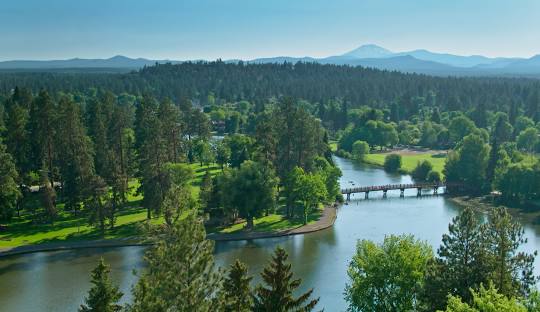

Top Outdoor Mecca Cities in the U.S. for Adventure Seekers (2025 Guide)
Some cities end up defined by what surrounds them. They weren’t built to be “outdoor destinations”, they just grew next to the kind of landscapes that make it easy to step outside and do something real. You notice it in the way people plan their days. The weather forecast isn’t small talk; it’s the start of a plan.
Life in these cities is practical and seasonal. People move there because they want access to the outdoors without giving up reliable internet, good schools, or an actual grocery store. They work from home, run local businesses, or teach at the nearby university, then spend weekends skiing, hiking, paddling, or climbing. There’s a sense that being outdoors isn’t an activity; it’s part of the week.
These cities tend to attract people who care about how they live more than what they own. The houses might be modest (or in the case of vacation meccas or hugely popular destinations, they can be very fancy), but the views aren’t. And while growth has brought traffic and higher costs to many of them, the trade-off still feels worth it: your free time takes place in the kind of settings other people travel for.
What Defines an Outdoor Mecca City
- Direct access to nature. Trails, rivers, lakes, or ski areas close enough to reach before or after work.
- A livable base. The town has what you need for daily life, jobs, schools, and healthcare, not just tourism infrastructure.
- An active social culture. Clubs, meetups, and volunteer trail groups fill the social calendar instead of traditional nightlife.
- Seasonal rhythm. Winters matter. Summers matter. The change of light and temperature shapes community life.
- Population size. Usually small to mid-sized — big enough for a functioning economy, small enough to keep the landscape visible from town.
- Environmental focus. Local politics and community projects often center around land use, water, and conservation.
Top Outdoor Mecca Cities
Bend, Oregon
Bend used to be a logging town. The mills closed, but the people stayed or showed up. They were drawn by rivers, forests, and open space. Today, it’s a mix of remote workers, plenty of young families, young people who moved here to ski and never left, and some of the healthiest retirees you'll ever meet.
Why It Works: Over 300 days of sunshine a year and everything within reach, including trails, mountains, and a real economy. It’s big enough to sustain jobs but small enough to keep nature close.
Boulder, Colorado
Boulder sits where the Great Plains end and the Rockies begin. Most people who live here have found a way to build work around time outside, not the other way around. The city is expensive, but the proximity to trails and stunning public land keeps it full.
Why It Works: Boulder manages to pair access to nature with serious careers — tech, education, and research all thrive alongside a deep outdoor culture.
Asheville, North Carolina
Asheville isn’t just a mountain town; it’s a full city that happens to sit between national forests. The outdoors and the arts coexist naturally here. You’ll find as many local bands as trailheads.
Why It Works: It’s one of the few outdoor cities with a balanced, year-round climate and a creative culture that values nature without treating it like a brand.
Bozeman, Montana
Bozeman still feels like Montana, even as it grows. It has a small downtown, a university, and quick access to wilderness. Winters are long, but that’s part of the rhythm; the same people skiing in January are floating the river by June.
**Why It Works: It keeps a clear boundary between town and wilderness. Both are close, but each gets to stay what it is.
Chattanooga, Tennessee
Chattanooga has rebuilt itself around its geography, cliffs, rivers, and ridges. Once industrial, now it’s an outdoor city that works for people with all kinds of jobs. Housing is still affordable, and the climbing and paddling are some of the best in the East.
Why It Works: It proves you don’t need mountains or high costs to live in an outdoor city. Access is what matters, and Chattanooga has plenty.
Living in an Outdoor City
Living in one of these places usually means fewer restaurants but more reasons to go outside. You get to know your neighbors because you see them on the same trails. Weekends depend on the weather, not reservations. There’s always something that needs fixing, gear, bikes, the roof, but that’s part of the trade.
If you want a life where free time and natural space overlap, these are the cities that make that possible.
-Take the LookyLOO Quiz
-Create Your MoveBook
to compare how outdoor life looks across different parts of the country.
FAQ About Outdoor Mecca Cities
Q: What makes a city an “outdoor mecca”?
A: It’s a place where you can live a normal life, work, have kids, get groceries, and still be outside most days without planning a trip. The outdoors isn’t separate from daily life.
Q: Are they all small towns?
A: Most are mid-sized. Big enough for jobs and healthcare, small enough that you can reach the trailhead in 20 minutes.
Q: Do you have to be outdoorsy to fit in?
A: No, but it helps if you like being around people who are. Outdoor cities attract people who talk about weather and snowpack more than sports or TV.
Q: What are the downsides?
A: Housing costs, short summers in mountain towns, and sometimes fewer career paths if you’re not remote. But the balance of work and environment is why most people stay.
Q: What’s the best way to know if it’s for you?
A: Spend a few days in the off-season, early spring in Bend, late fall in Bozeman. If the place still feels alive when the tourists are gone, it’s probably the right fit.